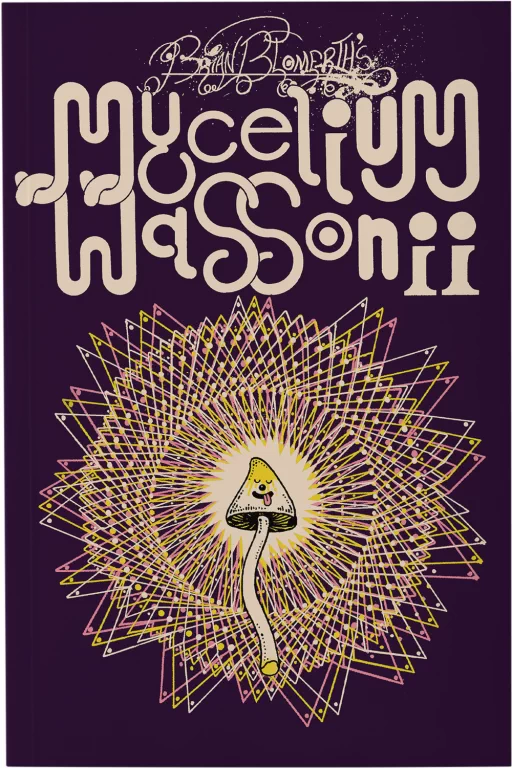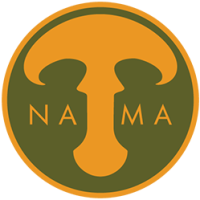I thought I already knew the story about Gordon and Tina Wasson—the amateur mycologists turned ethnomycologists who popularized psilocybin—so when Mycelium Wassonii, with its relatively drab cover and characters drawn as Goofyesque dogs bred by Walt Disney and R. Crumb, landed on my desk, it didn’t initially draw me in. Then, I cracked the cover and suddenly I was in love and didn’t want the book to end. I wanted to savor every word and each illustrated detail—I wanted to stay in the crescendo of the increasingly immersive, intricate, and color-washed Wassonii web.
At its vibrant heart, Mycelium Wassonii is a love story, a conversion story, and an account of how Valentina and Gordon Wasson uncovered and shared psilocybin’s magical attributes. It’s also a sequel to Brian Blomerth’s 2019 graphic novel Bicycle Day, “a historical account of the events of April 19, 1943, when Swiss chemist Albert Hofmann ingested an experimental dose of a new compound known as lysergic acid diethylamide and embarked on the world’s first acid trip” on his bicycle ride away from his lab at Sandoz Laboratories in Switzerland.
The web spun in Mycelium Wassonii fruits with the Wassons’ love, specifically, their 1927 honeymoon trip to the Catskills where they unexpectedly encounter wild mushrooms—a source of delight to Valentina, but a horror to Gordon who refuses to eat what his new wife has so enthusiastically gathered and prepared. Instead, he lies awake alone, realizing that he has ruined his wedding night and fearing that he will find Valentina dead in the kitchen.
Waking up next to her changes everything: Gordon rushes to the kitchen and eats a bolete and lots of other mushrooms; Valentina explains that mushrooms have been a part of her life since her childhood in Russia and that her mother taught her how to distinguish the delicious from the deadly.
Soon, Gordon decides he loves reading about mushrooms as much as he likes eating them. The illustrations of their date nights in the sumptuously detailed New York Public Library make their research seem as fun as a honeymoon foray, and as Gordon learns more about mushrooms and how they are used throughout the world, he develops an essay contrasting mycophilic cultures (like Russia’s) and his own English-influenced mycophobic upbringing.
Through a conversation with Robert Graves, a British literary celebrity, Gordon learns about “THE USE OF INTOXICATING MUSHROOMS AMONG MAZATECS IN MEXICO.” (Blomerth writes in all caps and employs idiosyncratic punctuation. He didn’t number the book’s pages, either so I can’t refer you to a specific one.) Gordon, Tina, and their daughter take a trip to Oaxaca where they encounter Maria Sabina, “A FIRST-CLASS CURANDERA.” Her generous tutelage more than satisfies the Wassons’ curiosity even as it diminishes Sabina; for example, she says that “EVER SINCE THE WASSONS CAME … THE MUSHROOMS STOPPED SPEAKING TO ME”.
At this point in the story, Blomerth has drawn magnificent mushrooms everywhere, deep in the margins, growing out of floorboards, at the ends of forks. The mushrooms even speak in runic speech balloons, as if they, too, are telling a story or commenting on Blomerth’s. “I GAVE THE MUSHROOMS A LANGUAGE,” he notes. “SHOULD YOU YEARN TO SUFFER, YOU CAN FIGURE THAT OUT.” I think most of us are trying, and Blomerth offers his encouragement: “I HOPE IT’S NOT LOST ON YOU DEAR READER THAT THIS IS A TRIUMPH OF AMATEUR MYCOLOGISTS.”
In other words, it’s a love story, and one that most NAMA members, figuring out the language of mushrooms, will enjoy. But Maria Sabina’s loss . . . . I hope that story can be told in more detail, with more sympathy and more mycology. In Mycelium Wassonii, her prediction, her last words, are “MAYBE THEY WILL SPEAK AGAIN . . . AS MEDICINE.”
Review by Barbara Ching, 2022


NAMA Store >